Serendip is an independent site partnering with faculty at multiple colleges and universities around the world. Happy exploring!
The Arc: An Exhibit on Right Relationships

----------------------------------------------------------------------------------------------------------------
The Arc
Written on the wall, to be seen as the first thing when entering the exhibit:
“Right relationships are human relations in which each (or all) seek, without abandoning themselves, to be attentive and responsive to the needs and emotions of one another, quite apart from considerations of entitlement. There are also several important “negative” markers of right relationships, namely they must be free of systematic oppression, exploitation or manipulation. That is, a relationship is not “right” if participants seek to overbear in power (oppress), to overreach in resources (exploit), or to mislead for selfish advantage (manipulate).” – John A. Humbach1
The introduction to this exhibit, to also be printed on the wall:
This exhibit aims to illustrate, through photographs, the arc of the relationship between gay and straight individuals. This arc starts with anti-gay hate crimes and stretches to end in the progress that we are finally beginning to see. Through the lens of Humbach’s “right relationships”, I have endeavored to explore, through imagery, what so many of us are unable to express in words – that although we have come far in support of a better relationship between the gay and the straight community, we are still not perfect. Hate crimes continue to happen, intolerance can still be found, and yet, we continue to move forward, to continue to attempt to attain a more perfect, more equal world. With gay individuals now portrayed in the media in highly developed roles and laws being put into place to legalize gay marriage, this “right relationship” is becoming more committed, more recognized, better.
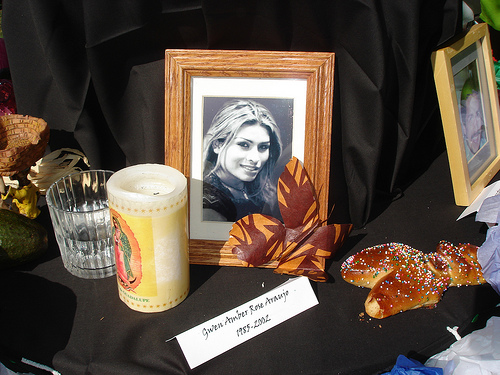
Gwen Amber Rose Araujo (1985 - 2002)
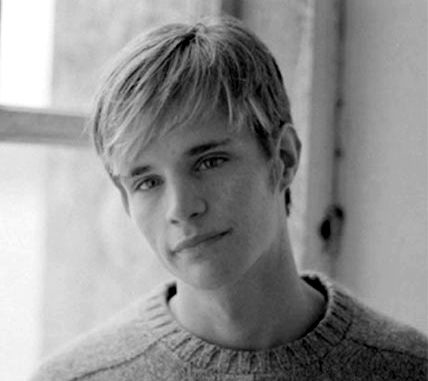
Matthew Wayne Shepard (1976 -1998)
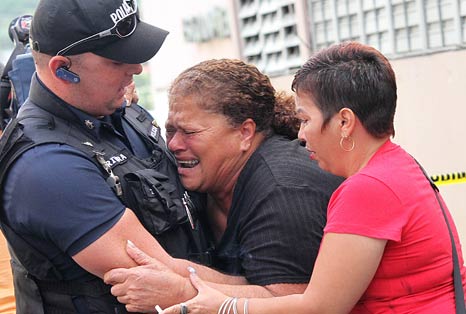
Family
Family of Ashley Santiago upon learning of her murder
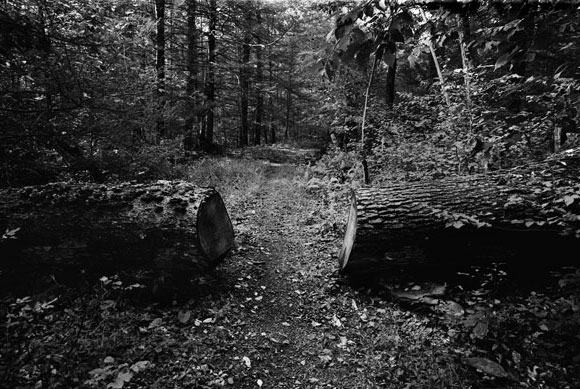
Into the Woods
Crime scene where lesbian lovers Lollie Winans and Julianne Williams were found murdered; Appalachian Trial
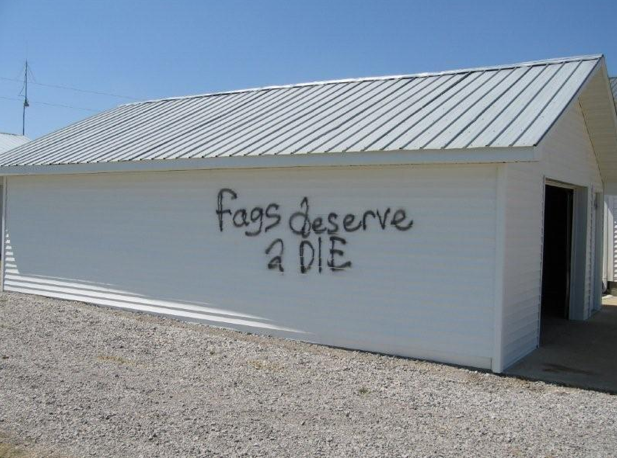
fags deserve 2 DIE
McMinnville, Tennessee
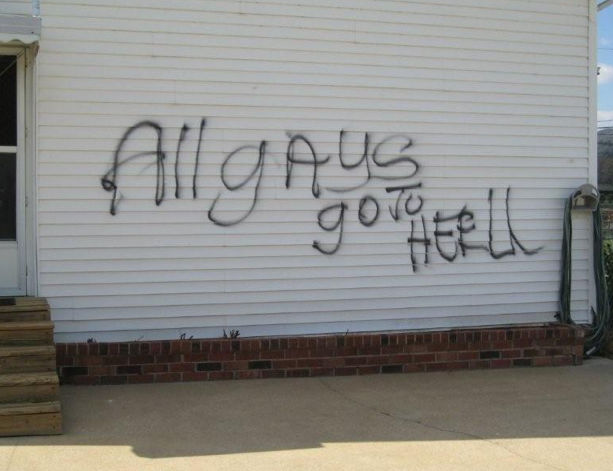
All gays go To Hell
McMinnville, Tenessee
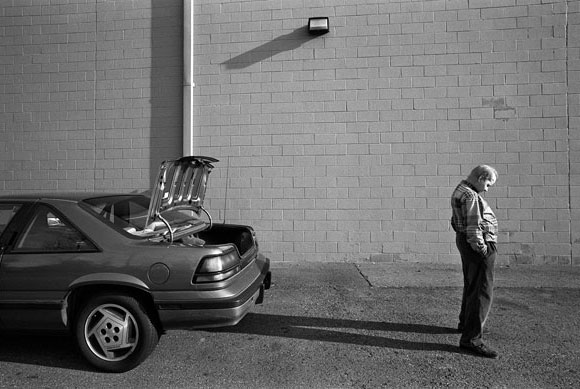
Unbreaking
Evan Kittredge, pictured with his car, was beaten, tied up, and placed in the trunk of his car and left to die in 1999. When his parents realized that he had not come home, they began to look for Ean;s car. Police found Evan and the car and miraculously he was alive.
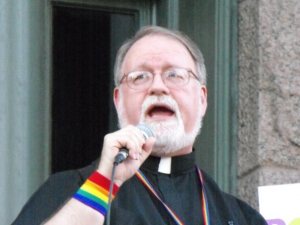
Dr. Sprinkle
Dr. Sprinkle hosted the Tarrant County trangender Day of Remembrance. He continually supports the LGBTQ community by speaking on thier behalf, marhcing with and for them, and is working towards an equal society. He is an ally.
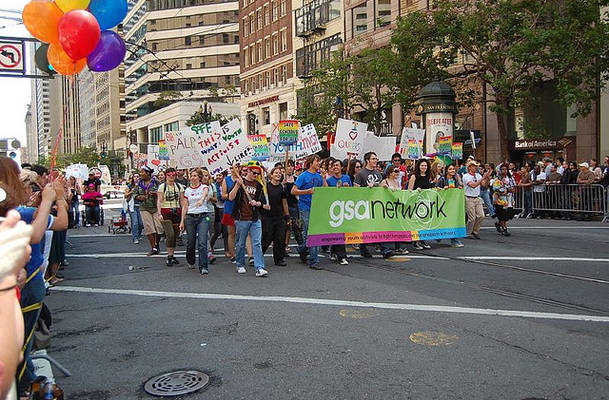
Walking Together
Gay-Straight Alliance, wlaking to show support
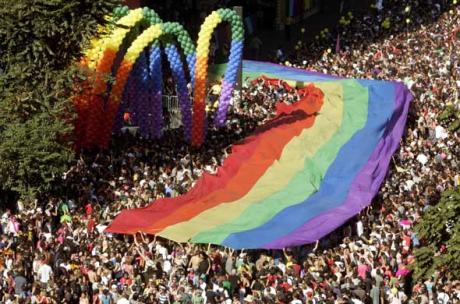
Sea of People, Sea of Pride
Gay Pride Parade
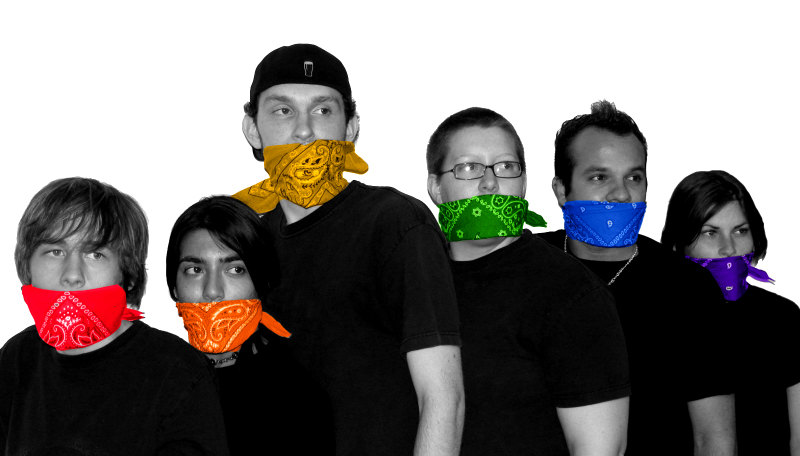
Day of Silence
The Day of Silence was created in honor of matthew Shepard, in which individuals elect to not speak for a day in support of gay individuals who are unable or afraid to speak out.
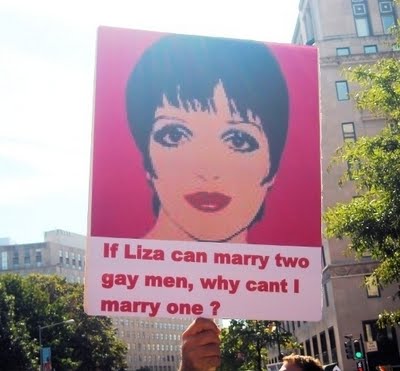
Signs I
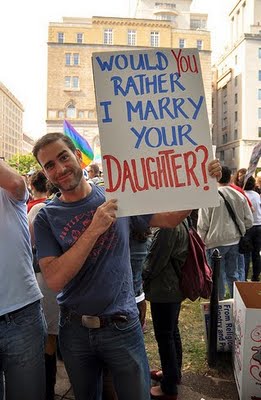
Signs II
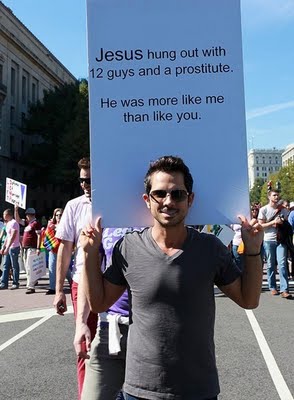
Signs III
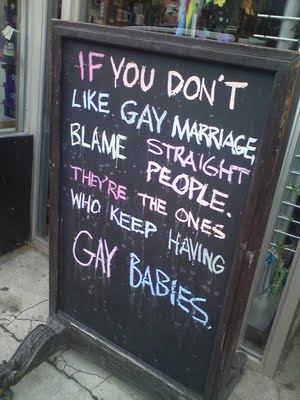
Untitled, Sandwich Board
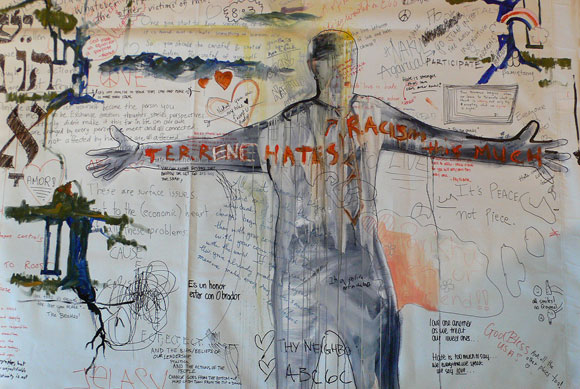
Community
Community art project supporting peace, coexistence, and love.
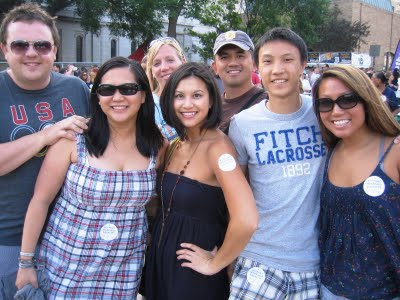
Support
Note: Stickers say, "I support marriage equality"

Ellen Degeneres and Portia De Rossi
Together 5 years, married August 2008
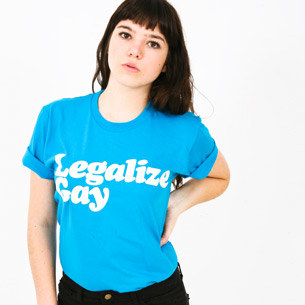
Legalize Gay
American Apparel clothing campaign

We Are Family
Gay dads and their adoptive daughter
--------------------------------------------------------------------------------------------------------
Response from viewers of the exhibit:
What are your initial reactions to this exhibit?
- I like the contrast of defeat and discrimination with messages of hope and progress
- The exhibit makes gay rights real, with real faces and people affected. Not sure that is really addresses the “right relationship” issue. I think a side by side view of all sexualities would be a good juxtaposition.
- It is interesting to see the images you have chosen many of which do not have dates. I was hit hardest by the graffiti which I felt could just as easily have been printed today as years ago
- I’d already seen the exhibit online and I really enjoyed viewing it in physical form. I was able to better visualize what you were aiming for in the exhibit. Also, I really liked that the squash court’s walls are not white – they’re dirty and messy and I think help underscore that the transition between non-alliance to right relationships is not one that comes with ease or without messiness.
- I noticed how some pictures were distinctly lacking human presence but just showed the emotion through words and posters. I think it made it interesting to see the arc through those two types of images.
- I guess my first reaction was shock a the violence and pain of the first couple photographs but the last couple photographs imbued within one a sign of hope.
- The beginning showed how much negativity the gay community received at first, with others even going so far as to murder people they thought were too different, and I know there are so many stories there, but I’d like to know what changed & how people decided to support the gay community & speak out in their favor.
- Interesting way to explore that relationship, I like the arc metaphor.
- I feel a small bit of connection to the exhibit because it imbues an ideal that I find correct.
How do you feel, surrounded by these photographs?
- The transitions from photographs which bring about sadness to more hopeful photographs gives the viewer a feeling of hope
- Supported. As a member of the group that has been outspokenly discriminatory, for so long, and in such a violent way towards the gay community, I am inspired to see that despite those who identify with the same sexual orientation as I do, and who have chosen to express their disapproval at the expense of all others, there is still hope to salvage what I believe to be an extremely important line of communication between people of different sexual orientation.
- I felt both sadness at how it began and hopefulness at how the relationship between gay members of society and everyone else began to progress into a more open and accepting relationship.
- Part of me feels overwhelmed; another part of me feels hopeful that the pain of the first couple of photographs is only temporary.
- I feel that even though the end of the arc had supportive messages, it goes full circle, and the hate from the beginning circles through to now.
- I feel a part of a larger community – a community of actors and image producers and viewers/listeners and inspired by the idea that these roles are not as clearly delineated as they once were.
- Struck by many emotions. Conflicted at times – i.e. the Legalize Gay tshirt that American Apparel makes, on the one hand yay! Publicity and making gay rights “fashionable” on the other hand all the bad publicity that American Apparel photographers have gotten for their treatment of models.
- There are a lot of non-heterosexual people seeking understanding and support and experiencing a lot of hate. I feel a lot more motivated to support and protect their rights.
- Too many are reflective of a lack of progress (which is a reflection of general public sentiment) which is depressing.
What lasting impressions are you leaving with?
- there’s so much more to be done – hopefully one day all of these photos can be like the fourth section.
- The fight feels like it’s done because of how the exhibit ended, but I realize it’s not. Mostly just keeping the picture of happy relationships in mind.
- I’m not sure how I feel or whether I agree that there is in fact an arc (a straight light, a trajectory). Think also the fact that all of these images are fairly recent makes me feel like there are pockets of acceptance – mutual love – alliances, but it isn’t universal. It’s also interesting to see the “look” of those represented here.
- I’m leaving with a resounding consideration of the power of messages – messages of hate, messages of hope, messages of solidarity – and the myriad of co-constructive ways by which they’re expressed, through words and images and alliances.
- That there is a range of emotions connected to this struggle – anger, sadness, fear, resentment, humor, and hope.
- The biggest lasting impression is the hope described above.
- The arc showed how far along the gay rights community has come, but I still felt like there was much more progress to be made.
- Reminder of the fact that these crimes and abuse are not of such small number that they can be called the exceptions. Times must change. Speak out.
- Hopefulness seems to be the strongest feeling obtained from the exhibit.
------------------------------------------------------------------------------------------
My response to the exhibit:
As I mentioned in my introduction to the gallery tour, I often find that words leave me at a loss. Yes, we can talk words, and theories, and plans, but where does that leave us? What does it mean? And truthfully, so what? If it is all in the abstract, can you truly understand it? Can you make anything of it? Can you embody it, be it, really know what it means? I don’t think so. Personal experience and physicality mean a lot to me. For example, I can read all that I want to about the Occupy movement, but without having physically ever gone to an Occupy protest or camp, I don’t think I will ever fully grasp the ideals and meaning of the movement. Its theory and words are lost without a physical means for grounding itself for me.
I really feel as though this exhibit gave me a chance to better understand some of the theory that we read. I understand Barad’s theory of entanglement much more now. No individual from that picture is alone. Losing any one of them affects a myriad of other people. The image of Ashley Santiago is not, in fact, of Ashley, but of the people that she left behind. Her death, in many ways, will affect them in ways that it will never affect her. She will never wake up one morning and realize that she will not be at the breakfast table or calling to say hello – but they will. We are entangled in other ways as well, as demonstrated by the exhibit. These issues are not stand-alone issues. It is not ok to simply have one measure of equality put in place, but rather, these individuals as seen in the marching photographs, will keep marching until unequivocal equality is achieved. They are entangled together in this fight for a right relationship between everyone.
Though this exhibit and my making of it, I also thought a lot about the right to appear and conversely, the right to disappear. With a photograph like the one of Evan Kittredge, he had every right to disappear. He fought for his life inside of the trunk of his car. If he never wanted to be seen as a public persona, he had every right not to. But he didn’t. He refused to back down and give in to his attackers. He appeared and continued to appear to inform them, and every other anti-gay person out there that he was here and going no where. I on the other hand, thoroughly exercised my right to disappear. In my filming of my tour, I am standing behind the camera. I did so for two reasons. My biggest reason is that I am not ready to be an internet-intellectual attached to a face as yet. I am comfortable with putting my thoughts on the Internet, but only to an extent. I will not put my name out there, not because I am embarrassed by what I say or because I do not stand behind what I say. I do. I thoroughly believe in every word that I have posted to Serendip (and I apply the same level of meaning to my postings on Facebook as well as in emails.). But I think that typed words, especially with a tricky, touchy subject like gender and sexuality studies, often need spoken intonation and facial expressions in order to express the meaning that was intended and not be misunderstood. I also exorcised this right when I put myself behind the camera and not in front of the camera. Charlie, my online, Serendip username is separate from my physical person and I am as yet unwilling to combine the two.
I also found myself thinking about Chris Cleave’s Little Bee while reflecting on this exhibit as well. Like Little Bee, The Arc can be seen as both a call to action and/or a call to be informed. The relationship between Sarah and Little Bee is difficult, hard work to maintain, but very necessary, just as a relationship between the gay and straight communities. Unless we choose to live in a cabin in the wilderness without electricity, running water, or access to current events, we are never stand-alone beings. By our very nature, we are informed beings who seek a connection to those around us. We are all Little Bee and Sarah.
The Arc did more for me than conjure up deeper meanings of past texts. Seeing the exhibit live was a very different experience for me than it was seeing it on Serendip. Even though the exhibit was dreamed up in my head, seeing it live was a different experience for me. Just as simply reading Over It to oneself will never be as powerful as reading it out loud in a group setting. Through thinking about this, I began to think about what it means to put something on public display. What does that really mean? Is a crime like the murder of Matthew Shepard a public crime? It happened in public, but it was between two isolated groups of people – the bullies and Matthew. So is it private instead? I am willing to venture to say that it is. The portrait of Matthew included in The Arc is a public image of a private person. The back story of exactly what happened on that fateful day and what led up to his murder will remain a private story. But an images like “all gays go to hell: spray painted on the side of a house, that is a public hate crime, to me at least. It is a general statement directed at a group of people, specifically targeted at the individual whose home it was, but since it was written on the side of a house, on display, I would classify it as a public hate crime. Is there a difference in representation if it is written in public? I don’t think so. A hate crime, whether public or private aims for one end – diminishing the person on the other end, making them feel inferior and less worthy. Public or private, a hate crime is a hate crime. Yes, the actions of the crime itself may play out differently, but ultimately, it achieves the same goal.
I loved watching people walk through my exhibit today. I loved hearing people react to the images of Evan Kittredge, chuckling at the humorous posters asking why Liza Minelli got to marry two gay guys when they could marry zero, and smiling at the image of Ellen Degeneres and Portia De Rossi. Reading their comments was also interesting. I asked broad questions intentionally as I wanted my visitors to respond as truthfully as possible. I wanted to see first hand where they chose to go in reaction to the images that I had selected. I was happy to see that everyone picked up on the arc between images of pain and sorry through to images of progress. I was also happy to see that people felt and understood that although we have made progress, we are not done yet. One comment did disappoint me because he/she felt that I had not thoroughly achieved demonstrating the “right relationship” because I truly felt that I had, but I was pleased to see that others felt that I had done so. These relationships, both mine with the subject matter and the relationship between the gay and straight communities, will only continue to grow and strengthen the arc.
-----------------------------------------------------------------------------------------
Works Cited
Works Cited
(in order of the photographs)
1Humbach, John, Towards a Natural Justice of Right Relationships. Human Rights in Philosophy and Practice, Burton M. Leiser and Tom D. Campbell, eds., 2001. 1-18.
Gwen Amber Rose Araujo: http://www.flickr.com/photos/geminipoet/2976257596/
Matthew Wayne Shepard: http://www.stoppingthehate.com/News-Article17009_Hate_Crimes_Law_Signed_Protection_For_The_LGBT_Community.htm
Ashley Santiago: http://unfinishedlivesblog.com/2010/04/27/grief-and-outrage-over-transgender-murder-in-puerto-rico/
Lollie Winans and Julianne Williams, Evan Kittredge, community art project: http://www.lynnjohnsonphoto.com/index.php?s=galleries&p=hate
Spray painted messages: http://www.outandaboutnewspaper.com/article/1492
Dr. Sprinkle: http://unfinishedlivesblog.com/about/recent-activity/
GSA: http://www.allvoices.com/contributed-news/9192159-gaystraight-alliance-club-opposed-in-public-schools
Gay Pride parade: http://www.gaylife.org/gay-pride/
Day of Silence: http://www.fpujournalism.org/theexchange/2010/04/15/gay-straight-alliance-fights-to-break-the-silence/
Various signs, group wearing "I support marriage equality" stickers: http://thewildreed.blogspot.com/2011_07_01_archive.html
Ellen Degeneres and Portia De Rossi: http://hermajestymaude.blogspot.com/2009/12/top-10-real-life-celebrity-couples.html
Legalize Gay: http://www.nowpublic.com/culture/american-apparel-legalize-gay-t-shirt
Gay fathers and child: http://unicornbooty.com/blog/2011/10/21/adoption-by-gay-couples-increased-300-over-last-decade-in-america/
Barad, Karen. "Quantum Entanglements and Hauntological Relations of Inheritance: Dis/continuities, SpaceTime Enfoldings, and Justice-toCome."Derrida Today 3, 2 (2010): 240-268.
Butler, Judith, Lecture. “Gender Politics and the Right to Appear”. Bryn Mawr College, November 2011.
Cleave, Chris, Little Bee. New York: Simon and Schuster, 2009. 288 pp.
background information to help with searches:
http://answers.yahoo.com/question/index?qid=20090908193419AARdKiB
http://unfinishedlivesblog.com/the-victims/


